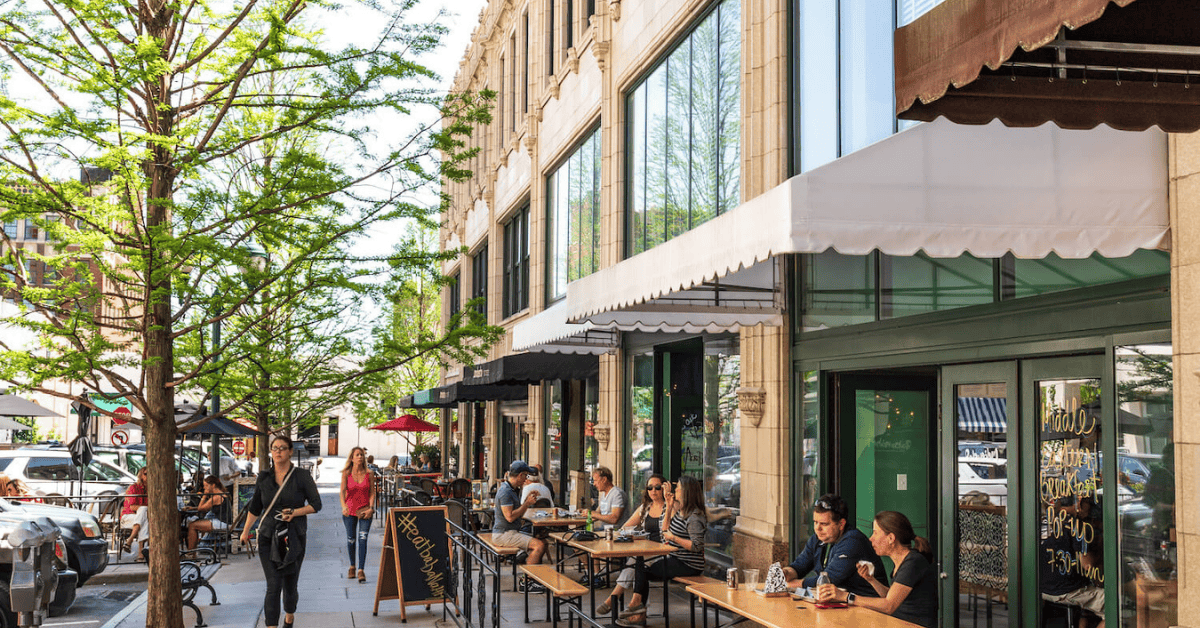Why City Downtowns Will Look Different Post-Pandemic

Urban downtowns have long revolved around office space. Soon, that may change.
Before COVID-19 hit the United States, American cities were seemingly defined by the crowds of workers commuting downtown for work and by the high-rise office buildings with their seas of cubicles. Then, the pandemic came, forcing companies to abandon their offices — and leaving eerily empty downtowns in its wake.
While some employers have already begun their return-to-office plans, others are closing their offices for good, instead embracing remote and hybrid working arrangements.
But what does that do to the once office-heavy downtowns scattered in cities across the country?
Here’s what you need to know.
The Downtown ‘Stress Test’ of COVID-19
Offices account for 71% of real estate across downtowns in the 30 largest U.S. metros, according to Brookings. In some downtown neighborhoods, offices made up as much as 90% of real estate.
Brookings calls COVID-19 “a profound stress test for downtowns,” which will likely continue to impact metros for years. Two years after the U.S. reported its first COVID-19 case, the demand for office space has only recently started to increase again.
In March 2022, demand for new office space increased by 20% after staying idle for five months, according to VTS. As companies bring employees back to their offices, demand has continued to surge in key U.S. markets, with major metros such as Los Angeles, New York City and Washington, D.C. making the most significant strides.
But even with the renewed interest, CNBC reported in May that office demand was only two-thirds of where it was before the pandemic. NAIOP data found that by the end of the second quarter of 2022, office vacancy rates had risen for 10 consecutive quarters.
NAIOP attributes the rising vacancy rates partly to the recent completion of new office buildings, leading it to project a positive net absorption. Leasing activity is also up year over year, and some downtowns are slowly beginning to buzz with activity again.
Because many office leases last for five years or more, downtowns may face another reckoning when those leases expire. Downtowns must become less dependent on office space to ensure the market stays stable when that happens.
Reusing, Revitalizing and Repurposing Old Offices
Downtown developers are brainstorming new, creative uses for empty office buildings to prevent those spaces from becoming costly eyesores.
The prime location of downtown offices has made them attractive candidates for apartment conversions in cities like Washington, D.C. and Philadelphia. Also, many office buildings are well-built with plenty of parking spaces, which are undeniable advantages for any downtown apartment complex.
In the last few years, nearly 15,000 U.S. offices have started new lives as apartments, according to NPR. Other office buildings have become hotels, self-storage facilities, last-mile industrial facilities and even urban farms. The possibilities are virtually limitless.
However, transforming office buildings is a long, complicated process that requires intimate knowledge of local laws and expert project management. For example, to create apartments out of offices in New York, you must know the local zoning resolution, building code, multiple dwelling code and the Landmarks Preservation Commission regulations.
Those interested in revitalizing an office building will need a real estate lawyer to navigate the city regulations and a third-party logistics partner to provide decommissioning, storage, moving and installation services.
Together, you and your partners can help ensure that downtown spaces remain as vibrant as ever, regardless of the local working preferences. Though city downtowns may never be quite the same as they were before the pandemic, they will always be strongholds of energy and culture.
Armstrong is the largest asset-based commercial services provider in the nation. Whether you are relocating, renovating, building or decommissioning, we’ve got you covered. Set your next project up for success by requesting a free quote.
